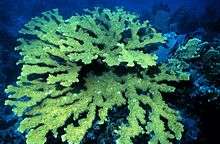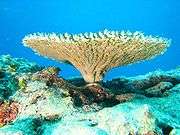Elkhorn coral
| Elkhorn coral | |
|---|---|
 | |
| Scientific classification | |
| Kingdom: | Animalia |
| Phylum: | Cnidaria |
| Class: | Anthozoa |
| Order: | Scleractinia |
| Family: | Acroporidae |
| Genus: | Acropora |
| Species: | A. palmata |
| Binomial name | |
| Acropora palmata (Lamarck, 1816)[1] | |
Elkhorn coral (Acropora palmata) is considered to be one of the most important reef-building corals in the Caribbean. This species is structurally complex with many large branches. The coral structure resembles that of elk antlers. These branches create habitats for many other reef species, such as lobsters, parrot-fish, snapper shrimps and other reef fish. Elkhorn coral colonies are incredibly fast-growing, with an average growth rate of 5 to 10 cm (2.0 to 3.9 in) per year and can eventually grow up to 3.7 m (12 ft) in diameter. The color of this coral species ranges from brown to a yellowish-brown as a result of the symbiotic zooxanthellae living inside the tissue of this coral species. Zooxanthellae are a type of algae which photosynthesize to provide the coral with nutrients. The zooxanthellae are also capable of removing waste products from the coral. Historically, the majority of elkhorn coral reproduction has occurred asexually; this occurs when a branch of the coral breaks off and attaches to the substrate, forming a new colony, known as fragmentation. The degree to which local stands reproduce by fragmentation varies across the Caribbean, but on average, 50% of colonies are the result of fragmentation rather than sexual reproduction. Sexual reproduction occurs once a year in August or September when coral colonies release millions of gametes by broadcast spawning.
Elkhorn coral provides many homes for sealife and great scuba trips.
Distribution
Elkhorn coral exist in the Caribbean, the Bahamas, and Florida Keys. Its range reaches as far north as Biscayne National Park, Florida, and as far south as Curaçao and Venezuela. However, at least in part as a result of climate change, the range of elkhorn coral has expanded northward along the Florida peninsula and into the northern parts of the Gulf of Mexico.
Elkhorn corals are found primarily in shallow waters with temperatures between 26 and 30 °C (79 and 86 °F), and with significant water movement. They are one of the most abundant species in waters ranging from 1 to 5 m (3.3 to 16.4 ft) deep, and a few colonies have been reported from waters as deep as 20 m (66 ft) (e.g. Navassa Island).
Threats

Elkhorn coral was once one of the most abundant species of coral in the Caribbean and the Florida Keys. Since 1980, an estimated 90-95% of elkhorn coral has been lost. Threats include disease, coral bleaching, predation, climate change, storm damage, and human activity. All of these factors have created a synergistic effect that greatly diminishes the survival and reproductive success of elkhorn coral. Natural recovery of coral is a slow process, and may never occur with this species because so many factors inhibit its survival.
Diseases that affect elkhorn coral include white pox disease, white band disease, and black band disease. White pox disease, which only affects elkhorn coral, is caused by a fecal enterobacterium, Serratia marcescens. The disease is very contagious and commonly moves from one colony to its nearest neighbor. White pox creates white lesions on the coral skeleton and results in an average tissue loss of 2.5 cm2 (0.39 in2) per day, but can cause as much tissue loss as 10.5 cm2 (1.63 in2) per day. White band disease and black band disease have also greatly reduced the abundance of elkhorn coral. Diseases are one of the major causes of coral mortality, however, they are not well studied or understood.
Predators of elkhorn coral include coral-eating snails (Coralliophila abbreviata), polychaetes such as the bearded fireworm, and damselfish. Predation by these organisms reduces the corals' growth and ability to reproduce. Predation can eventually lead to the death of the coral colony.
Conservation
Several efforts to conserve the elkhorn coral have had mixed results. The Florida Keys National Marine Sanctuary has served as a protected region for the area’s coral species, and has also developed plans for the protection and restoration of elkhorn coral. Restoration efforts have included attempts to reattach coral fragments that were broken off during hurricanes or by ships. Attempts to reattach coral fragments have also occurred in Puerto Rico and the Virgin Islands, but all have had limited success.
Attempts are also being made to conserve the coral by culturing coral fragments. The Florida Keys National Marine Sanctuary, the National Oceanographic and Atmospheric Administration, and Mote Marine Laboratory all are having limited success with coral nurseries in the Florida Keys and Puerto Rico.
The National Oceanographic and Atmospheric Administration (NOAA) has developed and tested several ecological methods to restore this coral, including removing coral predators and reintroducing herbivores to the ecosystems to feed on harmful algae that grow on the coral.
In 2004, the Center for Biological Diversity requested the National Marine Fisheries Service (NMFS) to place elkhorn coral on the endangered species list. In 2005, NMFS decided elkhorn coral qualified as an endangered species under the Endangered Species Act of 1973. On May 4, 2006, elkhorn coral and staghorn coral (A. cervicornis) were officially placed on the Endangered Species List.
References
- ↑ WoRMS (2010). "Acropora palmata (Lamarck, 1816)". World Register of Marine Species. Retrieved 2011-12-09.
Further reading
- Grober-Dunsmore, Rikki; Victor Bonito; Thomas K. Frazer (Sep 8, 2006). "Potential inhibitors to recovery of Acropora palmata in populations in St. John, US Virgin Islands". Marine Ecology Progress Series. Inter-Research. 321: 123–132. doi:10.3354/meps321123.
- Mayor, Philippe A.; Caroline S. Rogers; Zandy M. Hillis-Starr (Mar 7, 2006). "Distribution and abundance of elkhorn coral, Acropora palmata, and prevalence of white-band disease at Buck Island Reef National Monument, St. Croix, US Virgin Islands". Coral Reefs. 25 (2): 239–242. doi:10.1007/s00338-006-0093-x.
- Patterson, Kathryn; James W. Porter; Kim B. Ritche; Shawn W. Polson; Erich Mueller; Esther C. Peters; Deborah L. Santavy; Garriet W. Smith (June 19, 2002). "The etiology of white pox, a lethal disease of the Caribbean elkhorn coral, Acropora palmata". PNAS. 99 (13): 8725–8730. doi:10.1073/pnas.092260099. PMC 124366
 . PMID 12077296.
. PMID 12077296. - Precht, William F.; Richard B. Aronson (Aug 2004). "Climate flickers and range shifts of reef corals". Frontiers in Ecology and the Environment. The Ecological Society of America. 6 (2): 307–314. doi:10.2307/3868406.
- Willams, Jr., Ernest H.; Paul J. Baterls; Lucy Bunkley-Williams (Dec 1999). "Predicted disappearance of coral-reef ramparts: a direct result of major ecological disturbances". Global Change Biology. Blackwell Science Ltd. 5 (8): 839–845. doi:10.1046/j.1365-2486.1999.00272.x.
- Baums, IB; Miller MW; Hellberg ME (2006). "Geographic variation in clonal structure in a reef building Caribbean coral, Acropora palmata". Ecological Monographs. Ecological Society of America. 76 (4): 503–519. doi:10.1890/0012-9615(2006)076[0503:GVICSI]2.0.CO;2.
- Critical habitat under the Endangered Species Act
External links
| Wikispecies has information related to: Acropora |

